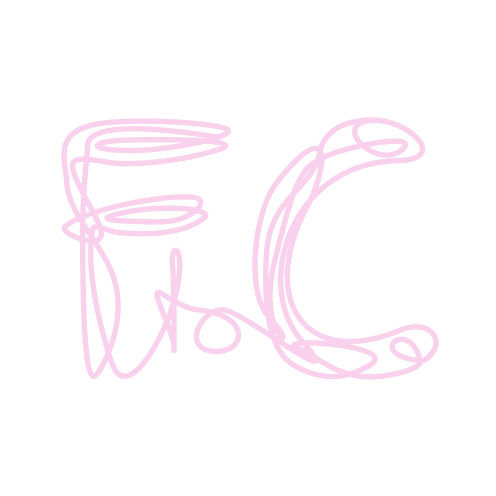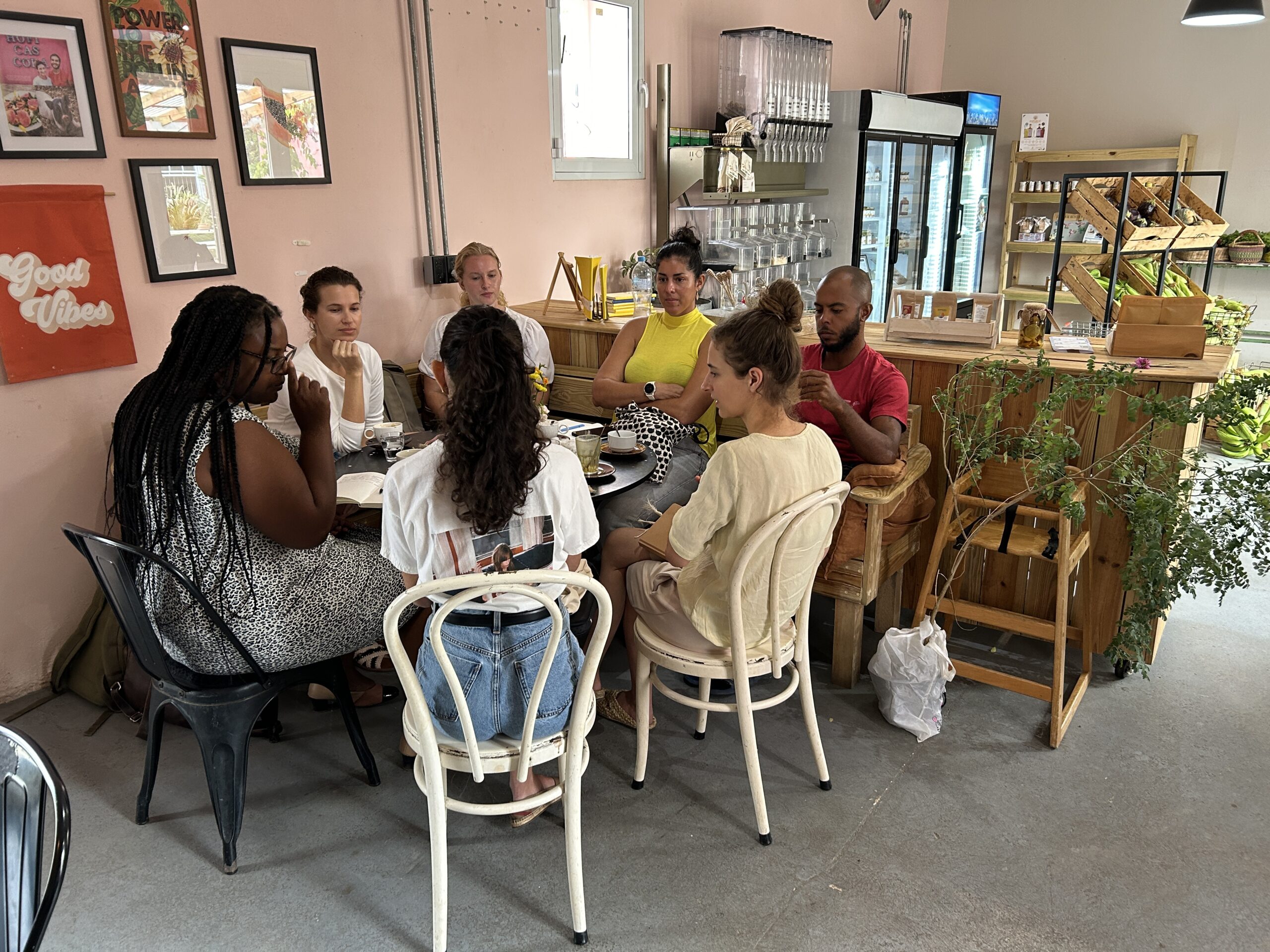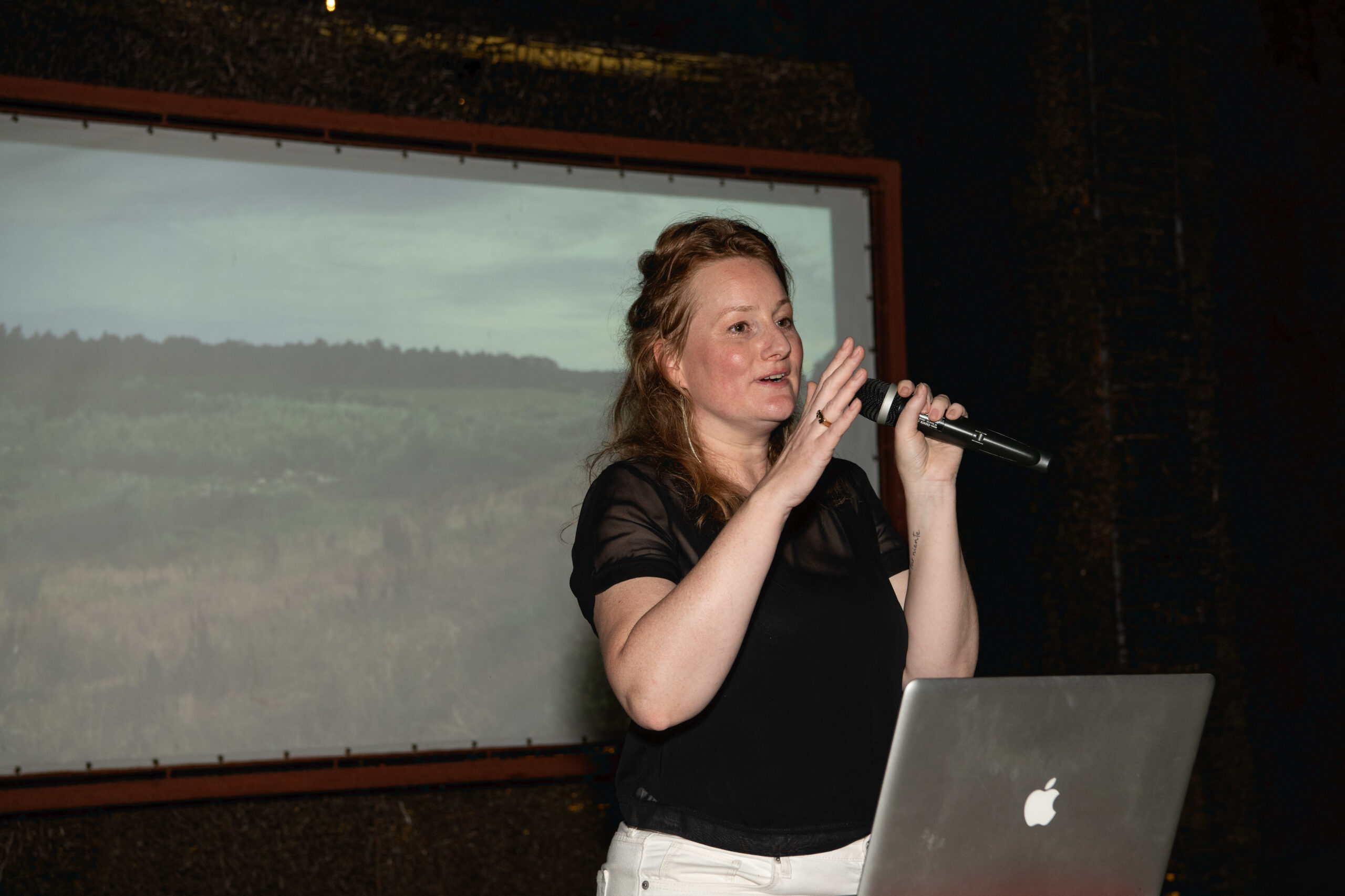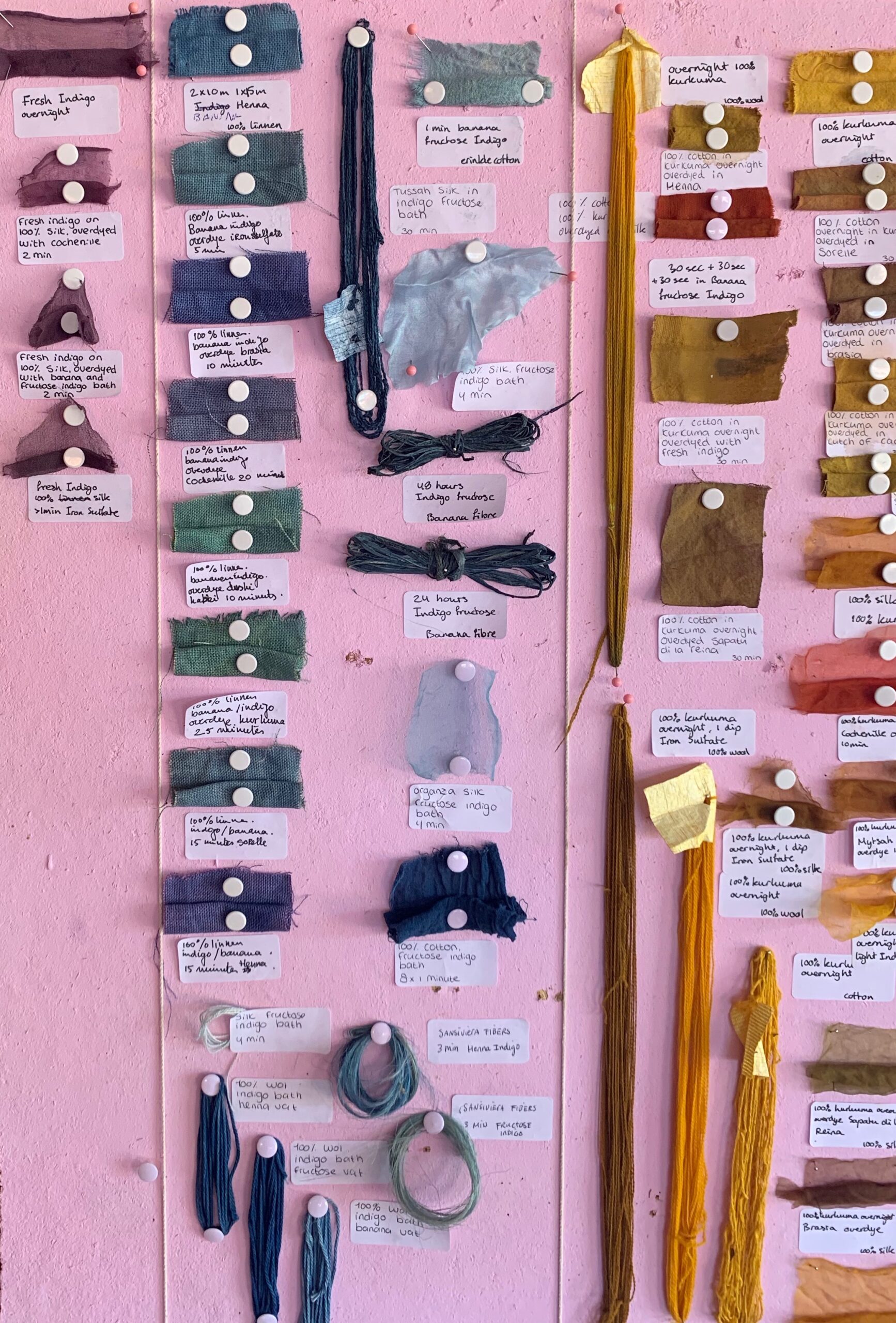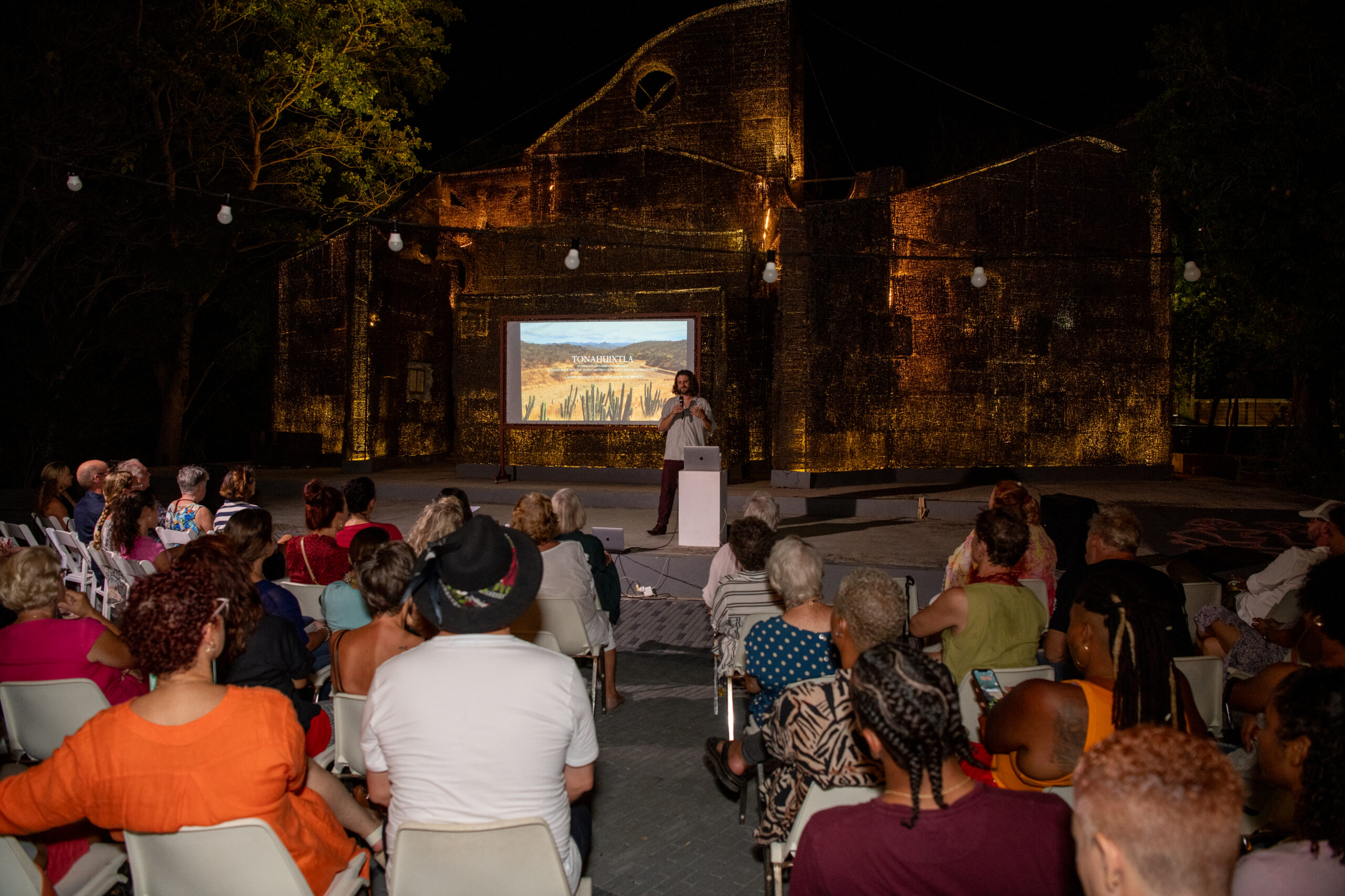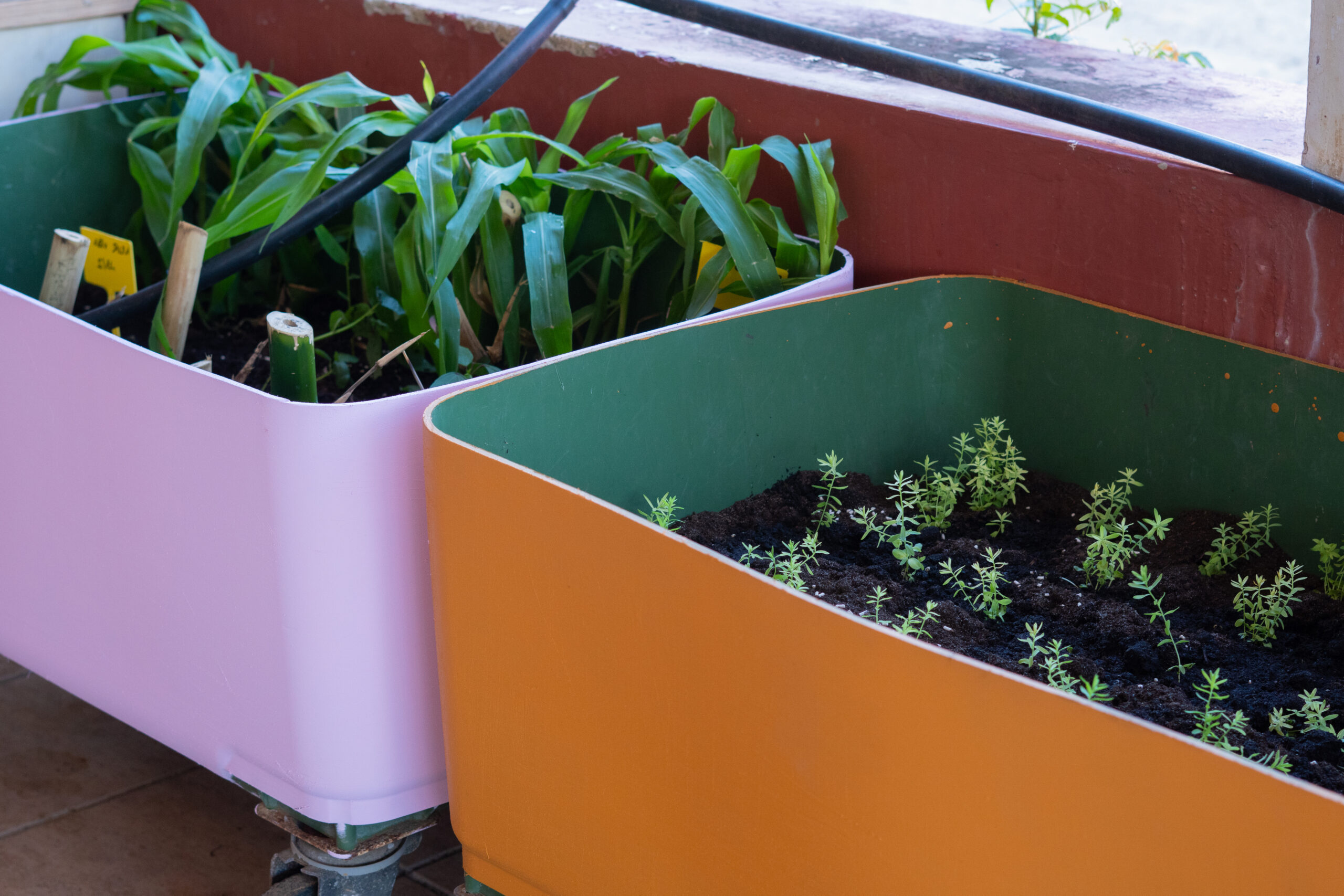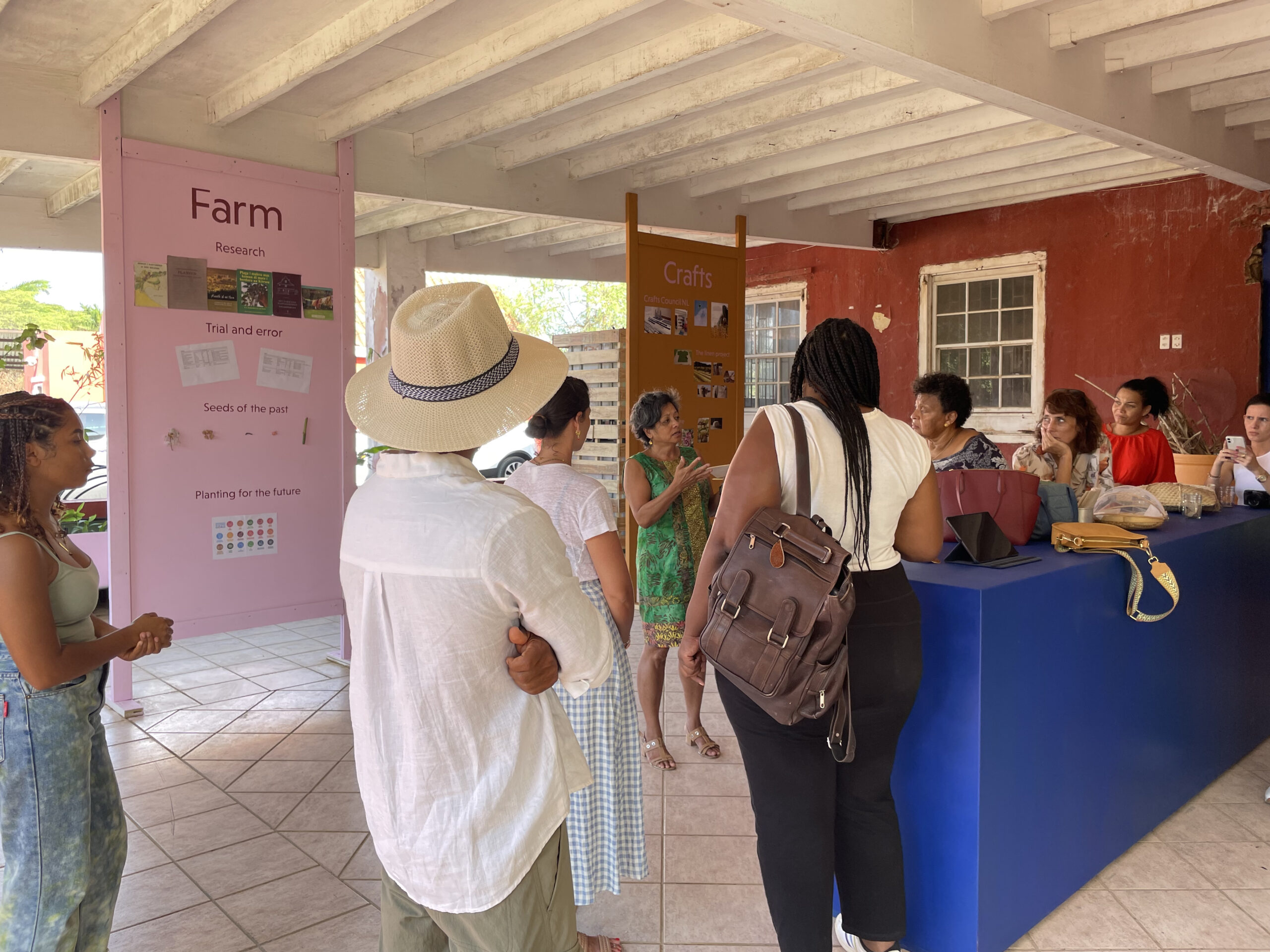Farm to Crafts finds its footing with banana fibers
Nienke Hoogvliet's presentation at The Cathedral of Thorns attracts the largest crowd till date. Despite it being a weekday, in the midst of the busy carnival season, it's a full house. The Dutch designer is visiting the island for the first time, but her fame has already reached the audience.
Reading Nienke's resume inspires enthusiasm. Her commitment to sustainability is seen in all her projects. From transforming seaweed into natural dyes and yarns to transforming wastewater into bioplastic. During her stay on the island, she returns to the basics of Farm to Crafts. How can we help local farmers while also connecting Curaçao's crafts industry? Her research leads her to the banana.
Curaçaoan Cuisine
In a Curaçaoan meal, the plantain is indispensable. Sliced pieces are fried in oil and served as an extra with a meal. But banana stobá (stewed plantain) or sopi banana (plantain soup) with pigtail are also part of Curaçaoan cuisine. The cradle of the banana is in Asia. The wild banana, which originally grew in the forest and was full of seeds, was estimated to have been domesticated about seven thousand years ago. In the sixteenth and seventeenth centuries, when the Latin American countries and the Caribbean islands were still colonies of Spain, Portugal, England, France, and the Netherlands, banana plants were already brought here, mostly as food for the enslaved on the plantations. It was during this period that the Portuguese and Spanish adopted the words banana and plátano from West African languages.
Research from 2022 among a group of 40 local regenerative farmers shows that bananas, papayas, and pumpkins are the most planted crops on the island. In addition to farmers in the field, the banana tree also stands in many households' gardens. After some persuasion from Nienke, the entire team is convinced of the potential of banana fibers. "The trunks of the banana plant are waste for many farmers because banana trees produce fruit only once in their lives. Moreover, a constant supply of crops is needed for the project's success," says farmer and designer Gino Martina, who still cherishes a preference for the softer fibers of the sansevieria.
Benefits
The trunk of the banana tree is not a real trunk but consists of leaf stems rolled together. The growing point is underground. Before flowering, this grows upward through the center of the pseudo-stem, and thus the inflorescence appears at the top of the plant. When the plant has finished blooming and the fruits are ripe, the trunk dies. One or more new shoots grow from underground growing points. In this way, the plant continues to live and multiplies by forming a clone of itself.
Farm to Crafts can buy the pseudo-stems from farmers, providing them with an additional source of income. "Now it's a matter of showing that you can also extract beautiful fibers from the banana for making ropes, mats, and woven fabrics. Also, the residual fibers of the banana are suitable for punching, a technique for making felt. But what makes it even more interesting are the by-products. The pulp of the banana stem contains a lot of cellulose. In theory, you can make handmade paper from that perfectly. And on the spot, I saw that the juice of the banana trunk stains. When Googling, I found out that there is a lot of tannin in bananas," says Nienke. "You can collect the extract for making natural paint." Tannin, also called tannic acid, helps improve color fixation on fibers, resulting in sustainable and vibrant color effects.
Hard work
For her research, Nienke works meticulously. Everything is documented. In images and writing. "Careful documentation is super important. One study is not a study, and one test is not a test. If you want to repeat something and you haven't documented it well, it's impossible to achieve the same results."
It soon becomes clear that abstracting fibers from the banana stems is not an easy process. "It's hard work and labor-intensive," says Nienke. Together with Gino and several volunteers, she worked in the field from 8 a.m. to 4 p.m. They collected the stems at Hòfi Cas Cora, laid them on the ground to drive over them with a car to crush them, and then abstracted the fibers by hand. For this, they scraped with a spoon over the crushed stems. At the end of the day, they had only ten usable strands. The purchase of a fiber extracting machine from China should facilitate this process.
Nienke herself suspects that the fibers can be even finer by first boiling them and then scraping them. The outer layer of the trunk has the most fibers that are the strongest. The inside of the tree results in softer fibers. Nienke: "In Japan, they grow non-edible bananas for the fibers, maybe those are softer?"
Luxury lounge chair
Coming up with a product was one of the assignments Nienke received before boarding the plane to Hato. At her final presentation, after more than two full weeks in Curaçao, she unveils her creation: a lounge chair with a curtain of falling banana fibers. "I want a product where the fiber comes into its own. The softness, strength, and length are emphasized with the lounge chair." At the drawing board, she first envisioned a burst of colors. A bright rainbow chair. But after intense discussion with the team, she opted for a different color palette. Project leader Cleo de Brabander argued for a final product where Nienke stays true to herself by using softer colors. "Nienke has already made a name for herself in the design world. Also, the market we are targeting, Dutch Design buyers, are likely not inclined towards bright colors."



In the end, Nienke opts for the stunning Curaçaoan sunset. The evening sky she admired every day from her balcony, filling her with awe. She mimics the colors with the dushi di kabei, or yellowwood (Chlorophora tinctoria), palu brasia, brazilwood (Haematoxylum brasiletto), and indigo. Natural resources growing on the island.
Nienke’s design invites touch. "The way an object feels to the touch intrigues me," says Nienke, who also experimented with a knotting technique for the banana fibers. "The idea is that the hanging banana fibers come between the knots. How many fibers do you need for that?" A question the team cannot yet answer.
Manageable
Since the inception of Farms to Crafts, it has become clear that extracting fibers takes time and is labor-intensive. "The chair is a year-long plan," says Cleo. "In the short term, paper is more useful. Banana paper is very practical, and the production knowledge is easy to share with others. Thus, a lampshade made of paper in different colors is manageable." Packaging paper and selling packs of colored sheets are also mentioned by the team as an option.
The paper production has not been worked out in detail yet. Nienke: "I’m still searching for the right pulp thickness. It requires some research. The pulp must be scooped onto paper using a frame. The thin layer on the frame is then pressed and dried until it has the right paper structure." Her own experiments show varying results. From fragile, almost transparent candy paper to thick cardboard with fibers running through it like veins. Volunteers to fine-tune paper production are already on standby.


Gift
Nienke hopes to inspire others with her research. She has printed her banana fibers report on thick paper. The visiting team of Stichting DOEN, who made her stay in Curaçao possible, bring the booklet as a gift. "The beauty of Farm to Crafts is the underlying goal of achieving a social income for farmers and crafters, producing less waste, and promoting appreciation for nature. You can actually create value from almost everything that grows on the island," Nienke said before bidding farewell to Curaçao. Browsing through the photo document, these words resonate.
Mix and Match: The Beauty of Curaçao Fibers
A coconut by the side of the road. Banana leaves on the ground. Designer Sanne Muiser views nature through the lens of fibers, and Curaçao is a treasure chest where fibers exist in large numbers. As a designing artist at the intersection of art, design, and research, she came to Curaçao in November 2023 to facilitate a workshop on needle felting. During this workshop, she uncovered a world of new textures, such as the softness of sansevieria, katuna di seda, and more.
Fascination
Sanne is the founder of Studio Pluis in Eindhoven, born out of a fascination with fibers; the fluff. ‘‘Fibers are the base of landscapes’’, says Sanne. She makes sense of the environment around her by exploring the landscape. Standing in the middle of the terrain, taking in everything with heightened senses. She begins a dialogue, from flora to fauna, with all the beings present. The landscape is not merely where she works, it’s the place the designer goes to gather knowledge. For the Dutch landscapes she explored sheep and wool fibres and retraced coffeebags to fique and jute. During her stay on the island she explored, together with Farm to Crafts, local fibres.
Participants in the two-day workshop started working with kapok fibers on the first day. First they removed the hard core from the white cotton that sticks out of the round fruits. The hard surface is detrimental to the needle. The feather-light brownish fluff floats with the wind and lands everywhere. "How primitive should the material be?" asks Marlies Schoenmakers. The ceramist is one of the 10 women following the first workshop series at the Farm to Crafts headquarters in Hòfi Cas Cora. The group consists mainly of artists and crafters, including artistic researcher and visual ethnographer Sharelly Emanuelson, ceramist Helen Martina, and art historian Josée Thissen-Rojer. Their curiosity about the needle felting technique brought them here.
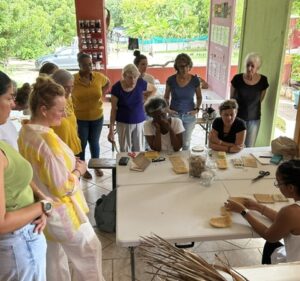

Basic Instruments
Needle felting is a craft that transforms raw fibers into matted fabric, which can then be turned into virtually any two- or three-dimensional creation, from a tapestry to a wall hanging to a piece of clothing. Participants start small with just two instruments: a felting brush mat and felting needles. The brush mat is a small square brush where you first place the bonding material. In this case, participants use various leaves, including druifi di laman (sea grape), but also discarded burlap coffee bean sacks. Then the needle is repeatedly stabbed into the fiber; the barbs pull the fiber in but prevent it from sliding back out. This action tangles the fibers and causes the scales to interlock, resulting in felting.
In just two days, the group created works that wouldn't look out of place in an art exhibition. A burlap bag with felting accents; an impressive (ritual) necklace by Eveline Sipkes made from sisal, palm leaf, coconut hair, kapok, and cotton; furry angel wings for Christmas decorations; a seascape painting, and experiments with synthetic and kinky natural hair.
Samples
For the second group, Sanne tightens the reins. The project's starting point, learning by doing, takes center stage. The created samples provide a broader view of the usability of local natural materials. "The beauty of fibers resonated with them, but also the possibilities of the material became very apparent. They were guided by the joy of creating. That's how they discovered the material's potential with this new technique", says Sanne.
Even she, a seasoned felter, got new insights. "Kapok from the trees here is amazing because it has its own color. The kapok I order from Indonesia is probably bleached first. The ones from Curaçao are soft and extremely fluffy. It needs something to stick to because it's super stubborn. The katuna di seda surprised me. The shrub grows by the road and is seen as a weed. The fiber is beautifully packaged in the fruit. It's ingenious how nature did that. The white fiber itself is very soft. In the Netherlands, it's comparable to blowing a dandelion away. It gives a very nice accent by felting four layers on top of each other. It also works well with kapok. The colors match beautifully, and in their natural state, they work very well together. Furthermore, coconut fibers never break. It's an extremely sustainable material. Coconut fibers are used in chairs and home accessories. You can make hammocks or coconut rope for lamps. There's more money to be made with interior products than with practical products, even if it's the same rope. In Hawaii, fishermen use coconut rope for their nets. It's a shame it's not done here."
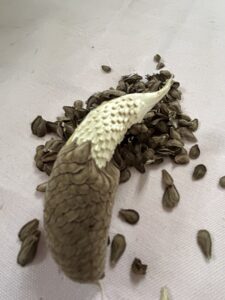

Tropical Africa
It turns out you can easily get fibers from the sansevieria. "When you shave off the leaf, long white hairs appear. These are super sturdy. You can even make nicer rope from them than from coconut. The sansevieria fibers almost look like horsehair. Combined with coconut fibers, it creates a beautiful combination for making chair seats or even wall coverings. The possibilities are numerous."
The Farm to Craft team has yet to discover which sansevieria species are the most pliable. Several types grow on the island. The sansevieria Thyrsiflora, also known as yerba di kolebra, yerba di sinta, and Rhamni on Curaçao and Bonaire, is a plant originating from tropical Africa suitable for pot culture and open ground. The leaf of the herbaceous plant grows upright and has gray-white transverse bands. The sansevieria Zeylanica is cultivated on Curaçao and Saba and is called 'orea di buriku,' according to the book 'Gekweekte en nuttige planten van de Nederlandse Antillen' (1954). As far as the shape is concerned, this plant is similar to the Thyrsiflora, but the leaves have a lighter color with a fairly wide yellow edge. The sansevieria used so far comes from one particular garden. According to Wikipedia, there are 66 species. About four species have already been identified on the island. "Which native species is easier to fiberize still needs to be investigated," explains Sanne.
Don't Harm Nature
The recycling streams of natural (waste) materials have yet to be mapped out. "There is still a lot untouched in Curaçao. You can pick up a whole stock of fibers with a pickup truck. I'm not talking about what hangs on the trees but collecting what's on the ground. There is no infrastructure for that yet. This can be realized on a modest scale. We don't want to harm nature. I am stunned at how much is imported. The coconut lies on the ground here. Banana leaves end up in a landfill. It’s astounding there’s no local production of coconut mats. The island doesn't need to compete with large industries. This project focuses on crafts. The goal is to increase the self-sufficiency of farmers and crafters. Small-scale crafts fit within the landscape and the size of the island. My advice is to engage in a conversation with the farms. Ask them what challenges they face so you can be of use and help them. Farming is already super complicated. If there's an occupational group that struggles, it's the local farmers.’’
She suspects that coconut or sansevieria can be seriously interesting for farmers. "You’ll need a good fiberizing technique to upgrade the material. In my studio, I also have coconut fibers that I ordered online. I had no idea what it takes to get the fibers from a coconut. The rubbery substance between the hairs and the nut has to be removed first. We had the participants do that. It’s extremely labor-intensive. You can also shred a coconut mechanically. There are special machines, a kind of washing drum with spikes. The coconut comes out completely clean. It's a non-chemical process. You can also easily build a DIY shredder, giving you a fiber in a much shorter time."
Sanne is also an advocate of transparency. "People should be able to read what the farmer gets out of it, the impact on the environment, etc. My core is not about sales. When I delved into Dutch wool, I wanted to make the chain accessible to the head shepherd who didn't know what to do with his wool." She followed the shepherd training to better understand the relationship between sheep and wool. It also gave her important insights into the creation of the Dutch landscape. This has shaped her vision of wool and its application. With the current discussion about worthless wool, she misses the conversation about the origin of wool and the welfare of the animal. In the end, the shepherd's wool has gained added value. "But I didn't start the project with the goal of increasing my income. That's a byproduct. In the end, I built something that won't go away. I'm connected to those sheep. It's in my DNA."
The 1, 2, 3 method of botanical dyeing
Loret Karman was conflicted when she received Farm to Crafts’ invitation to teach about botanical dyes. She wondered if she, a white woman, was the right person to share her knowledge about indigo. The history of the blue dye is deeply tied to slavery. "In the end I am very happy to have witnessed how the team works. My two weeks in Curaçao were a mutual exchange of knowledge and experience."
Together with her assistant Myra Scholma, she set up a dye studio at Hòfi Cas Cora for two weeks. During the first weekend, on September 9th and 10th, a group of fashion and product designers, textile enthusiasts, and individuals interested in cultural heritage participated in the indigo masterclass. Afterward, they delved into the fascinating world of botanical dyes. The Curaçaoan landscape turned out to be rich in plants from which dyes could be extracted.
Step 1
On the first day, the indigo dye is prepared from the plant's sap. Curaçao has two types of indigo plants, indigofera tinctoria and indigo suffruticosa. Both plants look almost identical, with the main difference lying in the seed pods. Indigo suffruticosa has curved pods, while indigo tinctoria has straight pods. The leaves contain the colorless indican, which is enzymatically split into glucose and indoxyl, with the latter substance transforming into indigo through air oxidation.
This process is explained step by step by Loret, assisted by Guenna Gustina, who experiments locally with natural dyes. First, the collected indigo is cut into pieces. "We want to obtain every piece of pigment. We don't let anything go to waste," says Loret. The branches, leaves, and pods are carefully weighed. Out of the 19 kilograms of indigo plants, almost one kilogram remains for the dye bath. "We need to make this more efficient," says environmental economist Cindy Eman.
An old bathtub from the renovated Kura Hulanda resort is filled with approximately 10 Liters of water, enough to immerse the indigo. The water immediately turns a light brown from the impurities. "This won't have an effect on the final product," assures Myra. Then, a black plastic garbage bag is placed on the water's surface. Heavy stones are used to keep the bag from blowing away. The sun shining directly on the bag boosts the fermentation and decomposition process.
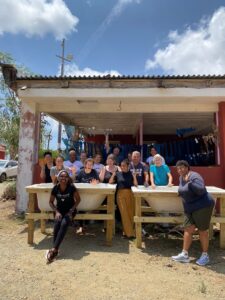
Step 2
While the fresh indigo ferments in the bath for the next 24 hours, the participants immerse themselves in creating three indigo vats. The indigo powder used for this purpose comes from India. Once the Indigo has been fermented it is still insoluble in water. The indigo must undergo reduction, a process of removing oxygen from the dye bath, making the dye soluble. Each vat includes three ingredients: one-part indigo pigment as the source of color, a two-part component to elevate the pH-value, and a three-parts reducing agent to remove oxygen from the dye liquid.
For today’s experiments Loret uses henna, bananas and fructose powder as reducing agents. Calcium hydroxide is the component to elevate the pH-value. Guenna transfers 30-gram indigo powder in a jar containing a few marbles. The marbles are an efficient way to hydrate the indigo. She then pours hot water in the jar, closes the lid and starts shaking the jar carefully. Next, 60 grams of calcium hydroxide are scooped from a bag. Face masks are worn to prevent inhaling the substance as it can cause irritation to the respiratory tract and nasal mucosa. Finally, 90 grams of fructose powder are weighed out. Meanwhile, 4 Liters of water are boiling in a stainless-steel pan.
This process is also repeated with the henna and banana pulp. The bananas are interchangeable with other fruits. "We could also explore whether mangoes, mispel (medlar) or tamarind are suitable options", says Loret after the participants indicate that these fruit trees leave owners with an oversupply. A significant portion of the overabundance goes to waste.
Step 3
Guenna has added the henna and indigo to the pan of boiling water. She then pours in two Liters of water, bringing the total amount of water to 6 Liters. The next step is adding 60 grams of calcium hydroxide. She stirs gently to prevent extra oxygen from entering. Aluminium spoons are prohibited due to the chemical reaction. "Someone needs to stir the mixture every half hour. An indigo vat is like a baby. It needs constant care", says Loret. "In Africa, they taste it to determine if it’s right", Guenna explains. "They have a connection with the material."
The Coloring
 Day 2. The beauty of Indigo dye is in the unpredictability of the results. As the cloth is pulled from the vat it appears green until exposure to the air oxidises the dye and turns it blue. Each time the cloth is dipped and exposed to the air the shade of blue gets deeper. The colour achieved depends on the type of vat used and the number of times the fabric is dipped. Darker indigo shades are achieved with multiple dips rather than a stronger dye bath.The same result can also be seen with the threads and various types of materials being dyed. Everything is meticulously recorded. Silk, linen, cotton, the type of henna vat, and the number of dips are all noted. This continued throughout the rest of the week as the participants worked with turmeric, cochineal, "dushi di kabei", "brasia", "divi divi", cutch of cachou (related to the wabi), sorrel, and "appeldam."
Day 2. The beauty of Indigo dye is in the unpredictability of the results. As the cloth is pulled from the vat it appears green until exposure to the air oxidises the dye and turns it blue. Each time the cloth is dipped and exposed to the air the shade of blue gets deeper. The colour achieved depends on the type of vat used and the number of times the fabric is dipped. Darker indigo shades are achieved with multiple dips rather than a stronger dye bath.The same result can also be seen with the threads and various types of materials being dyed. Everything is meticulously recorded. Silk, linen, cotton, the type of henna vat, and the number of dips are all noted. This continued throughout the rest of the week as the participants worked with turmeric, cochineal, "dushi di kabei", "brasia", "divi divi", cutch of cachou (related to the wabi), sorrel, and "appeldam."
The whole community was invited to admire the results on September 16th. Various shades of blue, yellow, and red/purple adorn the wall. According to Loret, this shows that you can extract primary colors from natural resources in Curaçao. The color expert mentioned that the 35 participants felt closer to nature during the workshops. The beauty of the colors also sparked a protective instinct in them. "In the beginning, we mostly created earthy colors, even with the henna. It was only after a few days, when we extracted dye from the brasia, that we felt a new wave of excitement", says Cleo de Brabander. The wood from the brasia produces an intense purple color. A craving for more purple emerged. Then it dawned on us. The greed we felt must have been experienced by the colonizers as well. That's why it became a hype in the 16th and 17th century. In the 19th century exports from Curaçao were much reduced, probably as a result of overexploitation. The brasia is a slow-growing tree. It takes at least 70 years before the tree is fully grown. Emotions ran high during the discussions. There were suggestions to keep the color a secret but also to introduce laws for the protection of the brasia and to start a tree nursery. By the way, the core of the trunk used in the workshop was imported from Haiti. No local trees were felled for this project."
Dark Side of Indigo Cultivation
Together with environmental economist Cindy Eman, Loret embarked on a journey through the mondi (natural areas) of Westpunt. "We arrived at the indigo bassins that were used during slavery. It was emotional. It's one thing to read about it, but to see it in real life. Wow, it still brings tears to my eyes. I could visualize the cruel forced labor. How the enslaved individuals had to pick indigo and make dye baths day in and day out under the scorching sun. They themselves gained nothing from it. The bassins are far away from the plantation house because of the foul odor. The story goes that those who worked in indigo production couldn't sleep with the other slaves because of the smell. The odor seeped into their skin. As a result, they were isolated. Nowadays, the working conditions are not any better. I've seen films of how they make indigo dye in India. It's inhumane."
Loret appreciated that the project provided an opportunity to discuss the darker side of indigo. The idea of reviving this industry stirred conflicting feelings within her. "Indigo cultivation is emblematic of the excesses of colonial times. Literal blood was shed to produce that beautiful blue color. The disastrous effects of this cultivation are virtually unmentioned in colonial records." In Afro-Curaçaoan culture, there is a tradition linked to indigo cultivation. Newborns are protected from the "evil eye" (oyada) with "blauwsel". This substance is rubbed on the crown or tailbone. Additionally, the plant is still used in folk medicine under the name ‘Jerba di seis’. In the early 20th century indigo was replaced by synthetic indigo, when it slipped into obscurity.
Indigo is now making a comeback in the States. Travelers to South Carolina can take artisan-led workshops on how to harvest and dye with the plant, and most of all, visit historic sites which explore the ugly past of this beautiful color.
Cochineal
Loret sees opportunities with cochineal. The Canary Islands, with EU support, have revitalized cochineal cultivation. Curaçao shares many similarities with the Spanish islands, both in terms of climate and economy. The cochineal insect feeds on the host plant (Opuntia ficus indica, also classified as Opuntia maxima and Opuntia tomentosa), which was introduced to the Canary Islands before the 19th century and is now a naturalised species on all of the islands on account of its agricultural value for cochineal farming. It is currently recognized by the European Union with the Protected Designation of Origin "Cochinilla de Canarias", being this archipelago the only European territory where cochineal is produced for commercialization. Coincidentally, Hòfi Cas Cora was one of the plantations in Curaçao that produced cochineal. The nopal cacti has been introduced on the island for the production of cochineal. But it never brought more than modest profit.
Written by Nelly Rosa
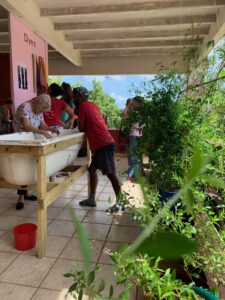
Mexican designer Fernando Laposse ‘Creative industries can power transformations’
The Mexican product and material designer Fernando Laposse (1988) ignited a flame during his stay in Curaçao. His critical questions awakened a deeper sense of purpose and a sharper focus for the future of Farm to Crafts.
His work is very aligned with the mission and vision of Farm to Crafts. Fernando first grabbed headlines with his Totomoxtle project, his first venture into transforming humble natural materials into refined objects. Corn husk – a food by-product that is normally thrown away – was harnessed as a puzzle-like veneer inlaid into various limited-edition furnishings and accessories. This was just the start. His projects have been exhibited in the Triennale di Milano, The Design Museum in London, and Miami Basel to name a few. His first solo show with New York’s Friedman Benda Gallery ‘Ghosts of our Towns’ runs until 14 October 2023.
The ambitions of the Farm to Crafts collective are similar to those of Fernando. The project seeks to enhance the self-sufficiency of the Curaçao economy by creating new ecosystems that connect the social, ecological, and cultural sectors.
Generational trauma
“I got a quick superficial look at Curaçao", says Fernando. “I am not claiming what the solution is. It seems to me that enticing people with money is not the answer. You first have to deal with the generational trauma of colonisation and slavery." For Afro-Curaçaoans farming has long been associated with forced labour. The typical reaction you hear is ‘I don’t want to go back to the plantation. I’m not a slave.’ One suggestion is to recast farming as a path toward empowerment and greening the earth. People should see the passion of reconnecting with nature and ancestral traditions. "They should be proud of their connection with their place. With pride you can realise more than with the possibility of money", says Fernando, who stayed a week on the island.
On August 23rd he gave a presentation at the Cathedral of Thorns about his work and experiences. Throughout his career he has focused on bringing to light traditional Mexican craftsmanship techniques that have remained under-recognized on the international scale. He has worked with materials such as sisal and loofah to create furniture that is as innovative and cosmopolitan as it is sustainable and ecologically sound. His work explores the impact of trade and consumption patterns on small farming communities, leading to environmental crises, loss of biodiversity, community disintegration, and forced migration.

Eco experiences
Fernando was deeply concerned about the loss of biodiversity due to advancing development projects on the island. "My most meaningful experience on the island was the hike with Frensel Mercelina from Uniek Curaçao (a NGO that focuses on raising awareness of the natural beauty of Curaçao among both the local population and tourists). His personal story touched me. After his retirement at the polluting refinery, he developed a passion for nature. He educated himself. His life mission in the second part of his life is to inspire others to reconnect with nature."
Frensel took him to Malpais and the area of Kokomo beach. The conservation area is government land. "Although there is an island development plan that delineates areas for urban development, industry, and conservation, it is often the conservation areas that are the most at risk. It can change into urban development with a stroke of a pen."
Fernando is a firm believer of providing eco experiences to increase awareness for nature conservation. "These aren’t targeted at tourists, but at local people to develop an emotional connection with the land and to enhance the understanding of symbolic ownership. Government land is land of the people. If communities have a love for the land, they are willing to protect it and treat their natural resources better. That is our role as practitioners of design. Designers aren’t persons that create a cute little object. We look at systems and challenge them.’’
This is what he does at home, in Mexico. By involving himself in the entire process, from planting to designing, Fernando highlights the connection between land regeneration and community revitalization, ultimately celebrating design as a tool for renewal.
Decolonization
When he started his practise in Mexico eight years ago, he had to decolonize himself as well. “At that time, I was still living in England. It was a tough process. Everything I learned was for a European reality. We grew up thinking that what came from the United States or Europe was always better. We need to create our own model. For my project I try to design for the most vulnerable indigenous populations in Mexico.’’ He doesn’t work with artisans, but trains people to learn the techniques required to make the product. “It’s about inventing our own cultural heritage, our own techniques, our own crafts and our own practice.’’
First, you need to define what crafts are, says Fernando. “For me, crafts involve manual work with low technology. Crafting is often rooted in tradition and relates to a cultural canon. It's something that whole communities can engage in. Craft is not a static concept; it can evolve and incorporate new innovations. Crafts are intended to be open source, meaning that knowledge and techniques are shared openly.’’
During his stay, he even produced a soft sisal lock from a local agave plant. The team's earlier attempts to create fibres from a different type of agave are in stark contrast to his "successful harvest". In terms of Curaçao's landscape Fernando believes both natural and cultural aspects provide a suitable environment for various crafts.
Bottom-up
Curaçao has a history of imposed craft. A good example of this is the Panama hat. The local Panama hats industry was a thriving business in the beginning of the 20th century. The hat weavers didn't earn much from it themselves and had a love-hate relationship with the work. They did it out of necessity, but it didn’t lift them out of poverty. Furthermore, the straw came from abroad.
Fernando stresses that imposed crafts and strategies don’t work. "It needs to be from the bottom up. Begin by restoring pride: a newfound pride in the natural environment, the collective materials, the act of craft making and last but not least pride in the eventual object. The object may not necessarily be a nod to the past but could symbolise the culture and the future of Curaçao. Creative industries can power transformations. The mere fact that creatives have the ability to dream and turning it a reality.’’
Clear message
Although his stay was short, Fernando gained a good understanding of how the team operates. He was blunt in his feedback. He believes that the Farm to Crafts message needs to be refined. "It should have a clear message." He also advocates for more visibility of the project, not only online but truly within the community by engaging in discussions about disconnection with nature, the history of slavery, and its impact.
"His visit and insights shook the very foundation of our project", says Farm to Crafts initiator Cleo de Brabander. "inspiring us to rediscover our path."
Written by Nelly Rosa

Recap of the first 6 months of farming experiments
Setting up the Framework
Farm to Crafts is an ongoing project aimed at investigating the feasibility of producing agricultural materials to support the local crafts industry. The project has a planned duration of one year. Typically, it takes a minimum of two to five years to establish regenerative agricultural practices. To expedite the process, a decision has been made to utilize large raised containers placed at the project site for experimentation purposes. These containers are positioned under a roof, receiving approximately 3-5 hours of direct sunlight. Additionally, they are equipped with a drip irrigation system that operates every other day for 15 minutes.
However, it has been observed that not all cultivated species in the containers are receiving sufficient sunlight. Some of the plants were mistakenly placed on the boundary of the location, where they were quickly consumed by livestock due to their exposure. In response, we decided to wait out the dry season and prepare for planting the most promising species directly into the ground in September 2023, just before the anticipated rainy season. To carry out this experiment, two rows will be designated within the grounds of Hofi Cas Cora. Companion planting and syntropic principles will be employed to enhance the soil quality. The selected species will be nurtured in a nursery before being transplanted into the soil as seedlings.
Species
To ensure the feasibility of our experiments within the scope of the project, we have chosen to focus on a limited number of species, which can be divided into two main categories: 1) Fibers and 2) Dyes. Within each category, we further distinguish between species that are cultivated specifically for this project and those that are sourced from existing farms, gardens, or directly from nature.
Fiber-producing plants typically yield fibers from their stalks or stems, such as flax and banana. Indigo, on the other hand, is extracted from the leaves and stalks of specific plants. Some species have fruits or flowers that can be utilized as a source of both fiber and dye, like cotton and butterfly pea. The selection of plants for this initial phase takes into consideration their growth rate, as some species are fast growers and can produce the required materials within a few months, while others require a longer period of maturity before they can be utilized.
In addition to growth rate, other factors that influenced our plant selection include maintenance and management requirements, as well as the potential for a species to become invasive. We have made a conscious decision to prioritize locally sourced and grown plants, aligning with our commitment to supporting the local ecosystem and community. For more data, have a look at this table providing an overview of the species.
overview of the species.
- Fibers
Various types of fibers can be extracted from different cultivated plants. Soft and woody fibers found just under the bast of certain plants, such as flax and hemp, are suitable for textiles and rope-making. Coarser, yet longer, fibers can be obtained from leaves of plants like agave and banana, which can also be used for ropes and twine. Hairy fibers can be extracted from specific seeds, as seen in the fluffy covering of the kapok tree (Ceiba pentandra) during its season, and the island also has a wild cotton plant with a historical significance.
In the initial phase of the project, the selected fiber species included flax, cotton, corn, bamboo, banana, agave, as well as other considerations like 'capim dourado' from Brazil, prickly pear, and pineapple. Promising results were observed during the initial sowing of flax; however, when the seedlings were transplanted into the soil, the harsh environmental conditions (such as extreme heat and intermittent downpours) proved to be too challenging, resulting in the failure of the test plots. Further testing with flax will continue every quarter, as its growing period is typically around 3 to 4 months, depending on the conditions.
During the test phase, cotton shrubs were found to be susceptible to pests. As part of future experiments, cotton will be incorporated into companion planting in open soil to assess whether combining it with other species can enhance its resilience. The growth period for cotton is approximately 5 months.
Corn, which grows quickly from seed, requires ample direct sunlight. For testing purposes, corn stalks are being sourced from other farms and will be an integral component of companion planting. The growth period for corn stalks is around 6 weeks.
Bamboo has been planted from cuttings and is currently growing in containers at the project headquarters. Additionally, bamboo has been harvested from gardens to provide materials for experiments. The time it takes for bamboo to reach the desired thickness can vary from months to years.
Bananas are sourced from discarded fruit waste at Hòfi Cas Còrá, diverting them from the waste stream for use in the experimental phase. Bananas generally take about 10 months to be ready for harvest.
Agave species are abundant in nature and gardens on the island. As these plants have slow growth, the decision was made to collect leaves for experiments and begin mapping the locations of suitable species.
Although other species like pineapple were considered earlier, they are not actively being researched at present. However, they have been planted and documented at other farms to provide materials for experimentation at a later stage.
- Dyes
The island has a rich history of using natural sources for vibrant colors. Divi divi pods (Ceasalpinia coriaria) were traditionally used to make ink, dushi kabei (Maclura tinctoria) provided textile dyes, and indigo (Indigofera tinctoria) and logwood (Haematoxylum brasiletto) were utilized for coloring both textiles and paper. Different parts of plants, such as flowers, bark, or fruit, were used depending on the species.
For the current project, several species have been considered and planted for dye production, including sorrel (Hibiscus sabdariffa), butterfly pea (Clitorea ternata), henna (Lawsonia inermis), indigo (Indigofera tinctoria and Indigofera suffruticosa), among others.
Sorrel, also known as Flor de Jamaica, thrives in the local climate and can be used in its entirety. The red flowers are used for dye production, while the plant also offers fibers. It typically takes 4 to 5 months for sorrel to reach maturity.
Butterfly pea is a climbing vine that develops blue flowers within approximately 100 days.
Henna, an imported plant that grows naturally on the island, takes around 3 years to mature. It can be harvested twice a year once fully grown, and the leaves yield a brown/orange color for dyeing.
At present, all these dye-producing species are being cultivated in containers at Hòfi Cas Còrá.
Indigo has been planted using seeds sourced from outside the island, but unfortunately, the seedlings did not survive. To increase the chances of successful growth, seeds were obtained from the local wild nature (mondi) and planted in various locations. Under favorable conditions, indigo plants can be ready for harvest within 3 to 4 months.
Second Half of 2023
During the remaining months of the year, our focus will be on harvesting the first materials grown from scratch and initiating a plot in the open soil. Simultaneously, we will continue to gather materials and seeds from nature, expanding our collection for future experiments and research.
Written by Cindy Eman
Farm to Crafts bridges the gap between farmers and the creative sector
Willemstad, Curaçao - "An eyeopener, inspiring, and collaborative." With these impressions from the first Farm to Crafts brainstorming session, attendees went home on May 20th. Although the team has been working for a few months, the session felt like the official kick-off of the sustainable project.
Over 16 people gathered at Hòfi Cas Cora, where they could see the efforts of cultural entrepreneur Cleo de Brabander, earth economist Cindy Eman, and product designer and farmer Gino Martina and dream about a circular economy where agriculture and the creative industry collaborate. Farm to Crafts aims to make local farmers more resilient by opening their eyes to new opportunities. The project primarily focuses on plants that produce fibers or from which natural dyes can be extracted. Take corn, for example. The stalks of corn cobs are usually discarded after the harvest, while fibers can be extracted from them," explains earth economist Cindy Eman. These fibers can then be used in the textile industry. Another example is bamboo, which grows easily and abundantly throughout the entire island. However, we pay high prices to get it imported. Almost everything can be made from bamboo. The material has been used in construction in Asia for thousands of years. Other places in the world utilize bamboo to create homes that are more energy efficient and environmentally friendly.
Another example is the Flor de Jamaica. According to Cindy, the beautiful, intense color of this hibiscus can serve as a natural dye. Almost everyone who went to school on the island knows of the blooming indigo production in Curaçao. At the end of the 17th and the beginning of the 18th century, many plantations had indigo plants to produce dye. This singular blue pigment was in high demand in the Netherlands. Indigo production became unprofitable in Curaçao during the 18th century because of the low prices on the global market. Nevertheless, the many stories about once thriving industries that discontinued do not discourage the initiators.
Workshops
In Europe, the United States, and Latin America, it is becoming increasingly common for farmers to collaborate closely with the creative sector. Soon, two product designers will be coming to Curaçao to conduct workshops. "Designer Fernando Laposse works with Mexican farmers to develop new business models. He creates furniture, carpets, and artworks using sisal - a fiber made from the agave plant", says Cleo de Brabander. Buyers readily pay around $7,000 for his dog bench made of sisal. Laposse's motivation to turn to natural raw materials is partly driven by the preservation of cultural traditions but also by concern for the environment. He believes that "some answers to the environmental challenges of the future might be found in traditional crafts rather than exclusively in new technological discoveries."
Dutch designer Nienke Hoogvliet is also coming to the island. Through Zeefier, she produces sustainable textile dyes on an industrial scale from seaweed. This demonstrates that artists, designers, and farmers have a lot to offer each other.
Inspiration
Cleo drew inspiration for Farm to Crafts from The Linen Project, an initiative of the Crafts Council Netherlands and ArtEZ Art Academy. This project not only resulted in the first Dutch organic flax harvest since the 1950s but also provided insights into how local production can be shaped in new ways.
Patrick Scannel is one of the participants who writes down various materials that are currently imported but could be grown locally. Such as palm leaves for palapas. The list is supplemented with watakeli trees, indigo, and includes considerations for livestock for tanning leather and the production of blood meal fertilizers for plants. Participants also come up with suggestions for the cosmetics industry, such as soap made from natural and animal ingredients.
Hierarchy
A prerequisite for success is a continuous supply of products, says art gallery owner Lusette Verboom, one of the participants in the brainstorming session. "In my experience, these initiatives fail if they are not seen as full-fledged businesses. It is possible to establish a sustainable enterprise with a hierarchical structure, where I pay people for the product and have a say in quality control. My advice is to start with the people who are already involved in this field."
She acknowledges that there is a fertile basis for cross-pollination between agriculture and creative entrepreneurs. Much is already being done with calabash fruit. By experimenting with innovative applications, new products could be developed.
Experiential tourism also offers opportunities for farmers and crafters. Through Airbnb, farmers can promote experiences. Crafters and artists can also offer creative workshops.
Beeswax
Artist Gwen Anderson leaves the brainstorming session with the contact information of a beekeeper. She is looking for beeswax. She uses the product to make paint. The import of beeswax is expensive, and Gwen hopes to find a more affordable option by purchasing locally. Leisure farmer Berber van Beek, knows a lot of farmers through her Hidden Green Movement. As luck would have it, she knows a beekeeper by name. In addition to networking, the brainstorming session has also been valuable for generating ideas.
Cynthia de Wind mainly saw her farmland as a means of producing food. "This session has encouraged me to think further. With the existing resources, I can explore multiple directions. The elephant grass can be used for making handicraft articles. The trunks of the 50 banana trees on the premises can also be utilized. I knew that the Flor de Jamaica is good for lowering high blood pressure, but the idea of using the flowers for extracting dye is new to me."
Research
Scientific research is also a branch of Farm to Crafts. The team had initial conversations with Wageningen University to collaborate on conducting experiments on the island. The warm climate of Curaçao serves as an alternative to conducting research in energy-consuming greenhouses in the Netherlands.
The gears in the mind of nature expert Frensel Mercelina are turning at full speed. He lists extracting dyes from the algae Dunaliella salina, which is responsible for the pink water in salt pans, but also exploring successful methods for cultivating the cochineal insect, as research endeavors which can be carried out by foreign companies and scientific institutions. Agricultural students from Groningen are already coming to the island for research in various fields, he says.
Trial and error
Experimentation is already taking place on the grounds of Hòfi Cas Cora, with its fair share of successes and setbacks. The first two flax harvests failed, partly due to excessive water and grazing by free-roaming livestock. They have also not yet succeeded in obtaining successful sisal fiber from the agave plants. "It's a process," says Gino Martina.
The enthusiastic responses from the participants in the first brainstorming session provided an extra boost to the initiators. The next step is to increase community involvement in the project. This includes data and material collection, as well as acting as ambassadors to spread the team's ideas within their networks.
Written by Nelly Rosa

